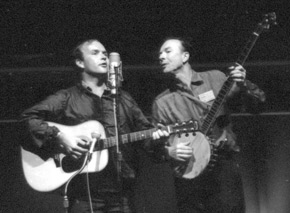Pete Seeger
I first saw Pete Seeger at Carnegie Hall in 1960. He was doing a series of hootenannies for Sing Out! Magazine and I was a new kid in New York, come to see the man who, for me and for my generation, was the driving force behind the rapidly growing folk music movement. Even in my seat in the far reaches of the upper balcony, his energy and spirit overwhelmed me.
On another occasion I was going from club to coffeehouse down in the Village, from The Gaslight to The Bitter End and small “basket houses” in between, greedy for every note of every folk song I could hear. Up on Bleecker Street stood The Village Gate, several rungs higher up the prestige ladder than any of the folk clubs where I occasionally got the chance to sing a song or two. The Village Gate played nationally known acts like Leon Bibb, Miriam Makeba, Woody Allen and, on this rare occasion, Pete Seeger. Whatever the admission price was, I didn’t have it, so I lurked in the lobby and caught a glimpse now and then through the curtain of Pete singing for a packed house. It was as thrilling for me as Carnegie Hall had been.
I finally met Pete in 1963. Everyone knew he had been blacklisted for years and was never on TV or commercial radio. When the Hootenanny show went on the TV (ironic that Pete had been largely responsible for coining the word) it was obvious to many that he belonged on it if anyone did. The producer, Fred Weintraub (who owned The Bitter End) claimed that there was no blacklist; no, no, Pete hadn’t been invited on to the show because they didn’t think he could hold an audience. Hello? Had they ever seen this man turn a crowd of thousands into an instant choir?
Several of us Village folksingers––Phil Ochs, Pat Sky, Dave Van Ronk, Eric Andersen, John Phillips and I, among others––decided to organize a boycott of Hootenanny. We had a few small meetings at our Morton Street apartment and then a large session one afternoon at The Village Gate. We must have had 50 or 60 performers there and our surprise visitor was Pete himself. Predictably, Pete argued that whatever its wrongs to him personally, the show, for him, had more to recommend it. He felt it could spread folk music to a far greater audience and that fact, for him, was persuasive. We talked it over and found we still felt that he was being unfairly treated and so the boycott went on.
After the meeting I got up my courage and approached Pete. I took off my figurative activist/organizer hat and stood revealed as a young songwriter looking for a breakl I asked Pete if I could sing him a song I’d just written. He never says no to a request like that and I was able to sing Ramblin’ Boy for him. To my great joy, he liked it and recorded it at Carnegie Hall I (I couldn’t believe it) in a reunion concert with The Weavers (How great was that?). Because he had just learned it he got the chorus slightly wrong, singing, “Fare thee well, my Ramblin’ Boy,” instead of “Here’s to you.” Not a big deal at all to someone as thrilled as I was.
Pete and his family took off on a year’s trip around the world and when the album came out, complete with Pete’s mistake, I received a post card from India, containing Pete’s signature drawing of a banjo and a message reading, “Dear Tom, Oops! Pete.”
When I wrote How Beautiful Upon The Mountain last summer and recorded it forComedians & Angels, Pete was prominent among those who inspired the song.
Alexandria, VA
March 2008